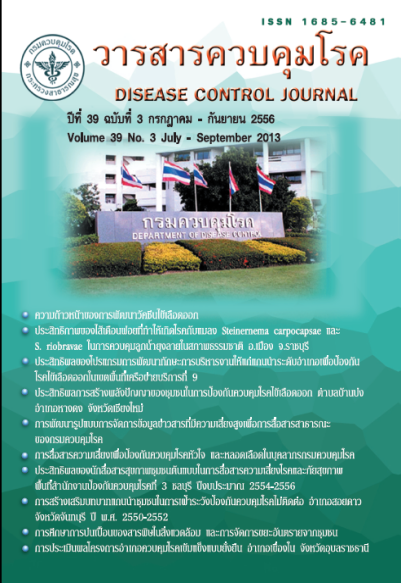Empowerment of community leaders to monitor and prevent non-communicable diseases in SoiDao District, Chantaburi, 2007-2009
DOI:
https://doi.org/10.14456/dcj.2013.17Keywords:
community leader, participatory learningAbstract
This action research to empower the leader to be aware of the health problems in their community and to strengthen their self-efficacy in promoting health by reducing the risks of non-communicable which affect themselves, their families, and community members. The participatory learning process was utilized to develop a learning process. The 57 samples were members of clubs and groups from six communities in Soi Dao District, Chantaburi Province. The questionnaires were collected before and after the meetings. The techniques used were AIC and PRA. The meetings last for 3 days in 2007-2009. The results showed that the community leaders participated in the meeting became aware of the disease monitoring and perceive the ability of themselves and their community members in solving the health problems, promoting health and reducing health risk (p value=0.000). The outcomes were that the leaders could analyze health problems and planed six interventions. Subsequently, the leaders and partners formed a working group and assign responsibilities in implementing the programs/projects with the support of Subdistrict Administrative Organization in their areas. After 3 months, the outcome monitoring found that all the projects had completed as planned although the budget was the reason why some activities lack continuity. Therefore, the village commission will be approached to set the budget in the following year's activities.
Downloads
References
2. อัญชณา แจ่มแสงทอง และคณะ. ประสิทธิผลการพัฒนารูปแบบป้องกันควบคุมความเสี่ยงโรคไม่ติดต่อ ในชุมชน จังหวัดจันทบุรี, 2550.
3. กนกวรรณ จึงประเสริฐ และภัทรพร อิทธิวรกุล.โครงการเสริมสร้างการมีส่วนร่วมของชุมชนเพื่อการ สร้างเสริมสุขภาพในการป้องกันควบคุมโรค (หัวใจความดันโลหิตสูง และเบาหวาน) จังหวัดปราจีนบุรี, 2546.
4. สมชัย จิรโรจน์วัฒน และคณะ. การเสริมสร้างและพัฒนาเครือข่ายเพื่อการเฝ้าระวังป้องกันควบคุมโรค:ขุมพลังชุมชนในพื้นที่ตำบลตะพง อำเภอเมืองจังหวัดระยอง. ชลบุรี: สำนักงานป้องกันควบคุมโรคที่ 3 จังหวัดชลบุรี, 2547.
5. สมชัย จิรโรจน์วัฒน และยุทธนา ประนุช.ประสิทธิผลการจัดโปรแกรม การสร้างพลังแกนนำชุมชน เพื่อการป้องกันและควบคุมโรคอุจจาระร่วงที่ต.ตะพง จ.ระยอง (online) แหล่งที่มา http://www.kmddc.go.th/library/research/research.dia3.pdf. มิถุนายน 2556.
6. คำแข แก้วพันนา และคณะ. คู่มือวิทยากรโครงการอบรมพัฒนาบุคลากรเพื่อการควบคุมป้องกันโรคติดต่อ โดยใช้หลักการ AIC และ PRA.กองฝึกอบรม กรมการพัฒนาชุมชน กระทรวงมหาดไทย; 2542. (เอกสารอัดสำเนา).
7. ครรชิต พุทธโกษา. การประเมินสภาวะชนบทแบบมีส่วนร่วม (Participatory Rural Appraisal:PAR).คู่มือการพัฒนาชุมชนแห่งการเรียนรู้ฉบับสมบูรณ์.2554. หน้า 12-13
8. อดิศร วงศ์คงเดช. ทุกข์ สมุทัย นิโรธ มรรค. กระบวนการวางแผนชุมชนแบบมีส่วนร่วม. เอกสารโรเนียวเย็บเล่ม. ศูนย์ฝึกอบรมและพัฒนาสุขภาพ ภาคประชาชนภาคตะวันออกเฉียงเหนือ จังหวัด
ขอนแก่น; 2549 น. 3.
9. มณี สุขประเสริฐ. บันทึกการเรียนรู้ การขับเคลื่อนงานป้องกันควบคุมโรคในชุมชนโดยกระบวนการมีส่วนร่วมของชุมชน (7 กรณีศึกษา). กรุงเทพมหานคร: โรงพิมพ์ชุมชนสหกรณ์การเกษตรแห่งประเทศไทยจำกัด; 2555.
10. ขนิษฐา กาญจนสินนท์. โครงสร้างและการเข้าถึงเครือข่ายเศรษฐกิจนอกระบบในชนบท. วิทยานิพนธ์ปริญญาพัฒนาศึกษาศาสตร์มหาบัณฑิต บัณฑิตวิทยาลัย มหาวิทยาลัยศรีนครินทรวิโรฒ ประสานมิตร;2536.
11. สำนักงานหลักประกันสุขภาพแห่งชาติ. การจัดการโรคเบาหวานความดันโลหิตสูง บทบาทที่ท้าทายของกองทุนสุขภาพ อบต./เทศบาล.กรุงเทพฯ: บริษัทยูเนี่ยนอุลตร้าไวโอเลตจำกัด;2554. น. 56-57
12. โกมาตร จึงเสถียรทรัพย์ และคณะ. วิถีชุมชนนนทบุรี: สำนักวิจัยสังคมและสุขภาพ; 2545.
13. ทวีวรรณ สัมพันธสิทธิ์. สถานการณ์การจัดการด้านสุขภาพขององค์การบริหารส่วนตำบลในแนวทางประชาคมตำบล กรณีศึกษาพื้นที่แม่ยวม อำเภอแม่สะเรียง จังหวัดแม่ฮ่องสอน 2550. สำนักงานสาธารณสุขจังหวัดแม่ฮ่องสอน. เอกสารอัดสำเนา.
14. สำนักโรคไม่ติดต่อ กรมควบคุมโรค กระทรวงสาธารณสุข. รายงานถอดบทเรียนชุมชนลดเสี่ยงลดโรคไม่ติดต่อเรื้อรังในชุมชน. กรุงเทพฯ: บริษัทอิโมชั่น อาร์ต จำกัด; 2553.
Downloads
Published
How to Cite
Issue
Section
License
Articles published in the Disease Control Journal are considered as academic work, research or analysis of the personal opinion of the authors, not the opinion of the Thailand Department of Disease Control or editorial team. The authors must be responsible for their articles.


.png)



